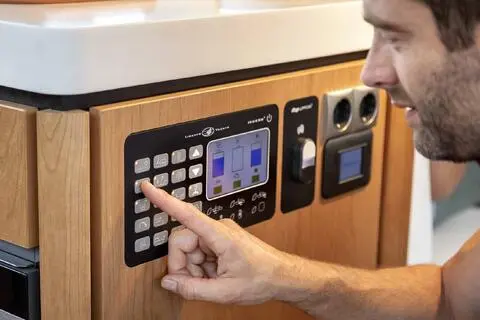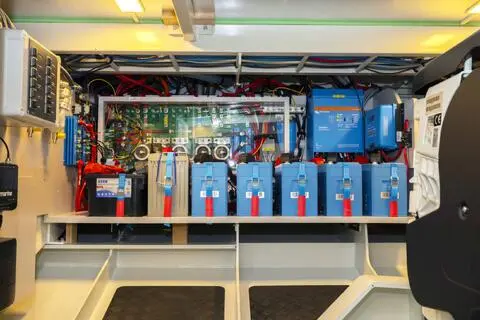ATTENTION
Due to Whitsun we are closed on Monday 20th May
Power supply on board of a motor yacht
Easy power supply on a Linssen motor yacht
Integrated CAN-bus Controlled Electric Supply System. ICCESS for short. Maybe you’ve heard the term before. Or read it on the control panels we use in all our steel displacement motor yachts. With ICCESS you always have all the important information to hand and you can easily operate the main functions on board your yacht. But ICCESS also provides clarity and convenience in the engine room. It’s a highly serviceable system. This is good for you, but also for the service technician you might get on board.
Control panels
You will find two ICCESS control panels on board our models. One panel is located in a central position in the living area, one panel next to the steering position. These panels, which used to be larger in size, have also been redesigned for ease of use.


There was a time when we had to pull the necessary metres of cable on board our yachts to make all the electrical systems work. At Linssen Yachts, we thought there had to be a more efficient and better way of doing this. And so our engineers have been working on this issue. With a successful result.
Linssen CAN-bus version for power on board
Ed Houben: “Nowadays, shipbuilding is also increasingly using CAN-bus (Controller Area Network) systems. This allows electronic devices to communicate with each other without the need for a separate cable for each communication flow. With most CAN-bus systems, however, you can still see that parts are installed all over the boat. This means that in the event of a malfunction, the user first has to search through countless hatches to trace the component in question. We didn’t want that. That’s why, being stubborn, we’ve come up with a Linssen version: ICCESS.”
Anything that needs power has a cable attached to it. The idea behind ICCESS is that all these cables come together in one central place in the engine room. From this point, one thin cable runs to the control panel. It’s a great example of system integration, if we say so ourselves.
Ed Houben: “A great deal of thought has gone into this. It has become an easy-to-read panel in which the icons make the various functions clear at a glance. From switching on the lights in the engine room to operating the electric anchor winch. It can be done at the push of a button. The display shows information such as the current level of the various tanks and battery voltages. Safety and warning signals from the on-board system also flash up on the panel.”
Easy serviceability in the engine room
Imagine you’re experiencing an electrical fault. When you contact our service organisation, the simplicity of ICCESS means that in many cases we can quickly point you to the right place in the engine room. And often also to the right component, thanks to the standard numbering system we use. A service technician who has little knowledge of CAN-bus and who comes on board with you, will undoubtedly be able to work with ICCESS. This is mainly due to the high degree of uniformity combined with conventional electrical components.
Ed Houben: “ICCESS is pretty dummy-proof. Of course, CAN-bus is a modern technology, but we have cleverly combined it with conventional electrical engineering. An average mechanic can handle that. ICCESS is our innovative answer to the makeshift cabling that you still too often encounter in the engine rooms of ‘modern yachts’."
